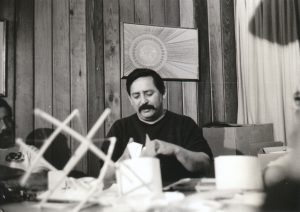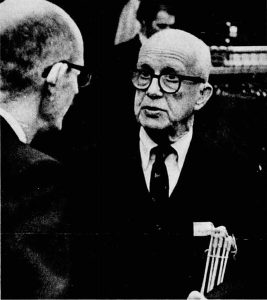“AN INVITATION TO GURULE”
FINAL TRANSCRIPT OCTOBER 22, 2017
Written by Benjamin Gurule,
Stephen James Taylor and Jesús Salvador Treviño
 In 1965 paper sculptor Ben Gurule discovered a system of geometric order. He found the system had its own laws as to how a group of wave-like strips of paper interweave to form stable, self-confining units. He called them space cages.” In an pre-internet age, Gurule was unaware that a few years before him British mathematician Robert Parteger, and several years after him, German mathematician and artist H.B. Mayer, had also discovered what they called plaited polyhedra.
In 1965 paper sculptor Ben Gurule discovered a system of geometric order. He found the system had its own laws as to how a group of wave-like strips of paper interweave to form stable, self-confining units. He called them space cages.” In an pre-internet age, Gurule was unaware that a few years before him British mathematician Robert Parteger, and several years after him, German mathematician and artist H.B. Mayer, had also discovered what they called plaited polyhedra.
Working independently, Gurule took the idea of plaited polyhedra further than Pargeter or Mayer, discovering a total of seven archetypal shell structures and codifying a set of laws explaining their order, characteristics and how they morphed into plaited polyhedra.
Gurule corresponded with Linus Pauling, Isaac Asimov and science writer Root Bernstein and met personally with Richard Feynman and Buckminister Fuller. All of them took a good look at his models, were fascinated by them but were unsure what to make of them.
Gurule discovered that plaited polyhedra, when unraveled, mirrored some of the properties of wave behavior. He found that by merely changing the amplitude while reversing the phase of the constituent strips of shell structures he could create different polyhedra, reversing the chirality of the original structures resulting in their mathematical dual.
 He became intrigued with how some of the system’s properties were analogous to certain attributes of subatomic particle behavior. His polyhedra are woven together in such a way that spin symmetries can be attributed to them at their vertices and faces.
He became intrigued with how some of the system’s properties were analogous to certain attributes of subatomic particle behavior. His polyhedra are woven together in such a way that spin symmetries can be attributed to them at their vertices and faces.
In 2014, G.S. Anagnostatos, working at the Institute of Nuclear and Particle Physics in Greece, posited that polyhedral symmetries were indeed directly linked to quantum mechanics. This is something that Gurule had long suspected but he did not have the mathematical background to corroborate it.
Other investigators– Ramón Carbó Dorca, John Schliemann and others– have also identified a link between the properties of polyhydra and quantum mechanics.
Anagnostatos asserted that the symmetries of polyhedra identically described the quantization of orbital angular momentum, of spin, and of total angular momentum when quantum states were assigned at the vertices of these polyhedra and when the average particle positions were assigned at these vertices. Gurule also found that the vertices of plaited polyhedra possessed systematically determined spin and chirality.
Zilong Kong, a Chiinese researcher in a 2013 paper in the Journal of Modern Physics haslinked electron shell stability and motion to a magnetic force octohedron similar to Gurule’s dynamic polyhedra. Kong’s diagram shows that the vertices of a cube are actually electron vortices whose spin configuration exactly matches the topological chirality of Gurule’s Q3 woven cube. Gurule also found that the vertices of plaited polyhedra possessed systematically determined spin and chirality.
Ben Gurule passed away in 2014, before he could further his explorations. What remains is an enigma: there appears to be “something there,” but what is it?
Because of your expertise we’d like to make a presentation to you of Gurule’s speculations with attendant models. Our hope is that perhaps you will find something familiar or resonant with your field of study that will shine a new light on the purported link between polyhedra and quantum mechanics.